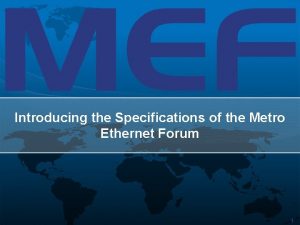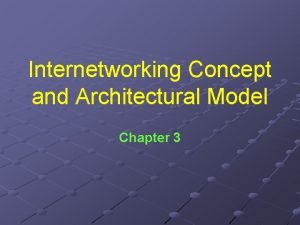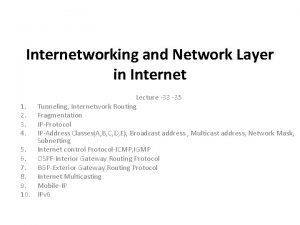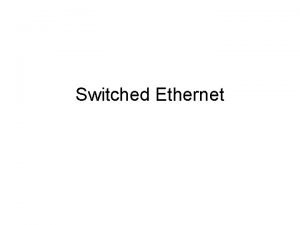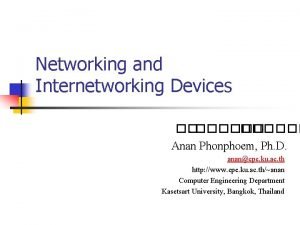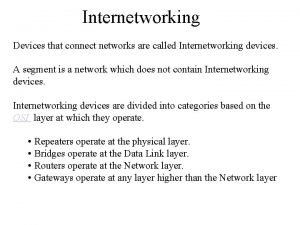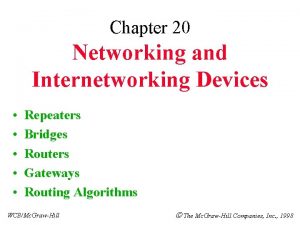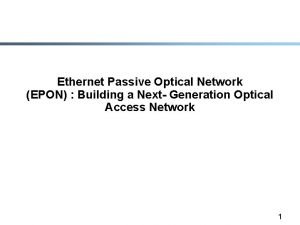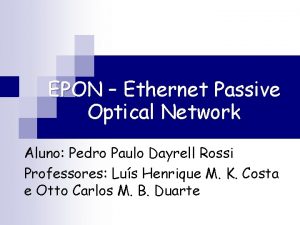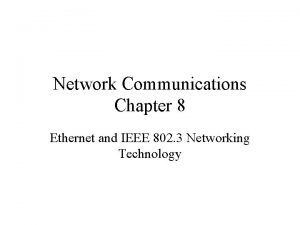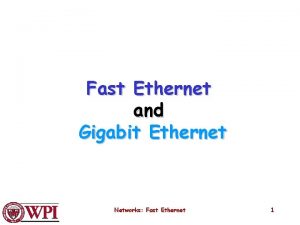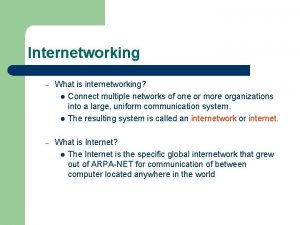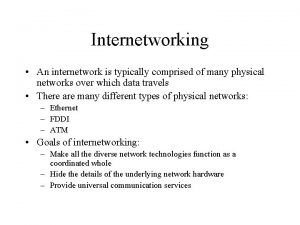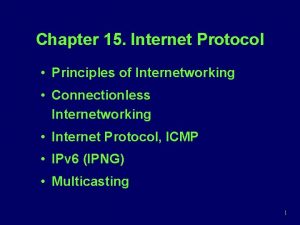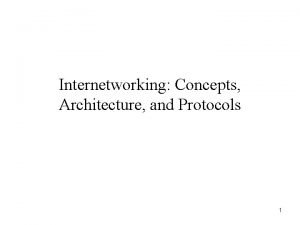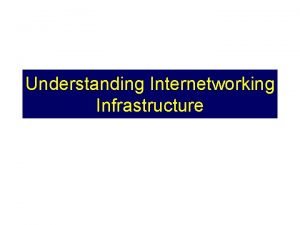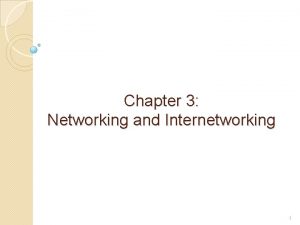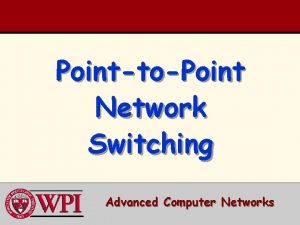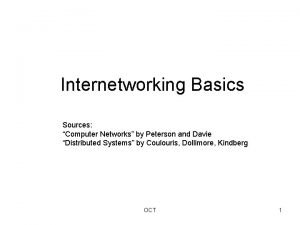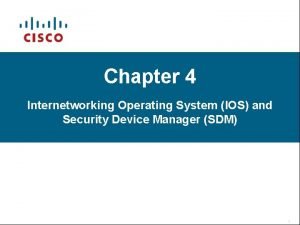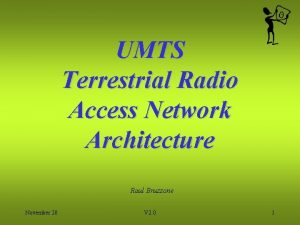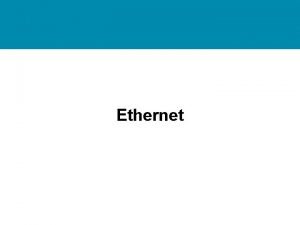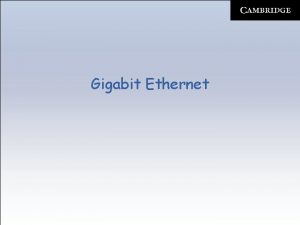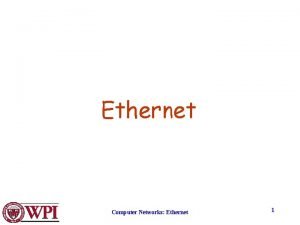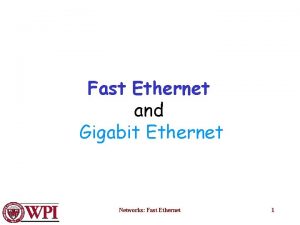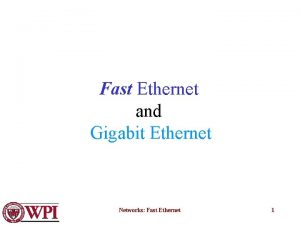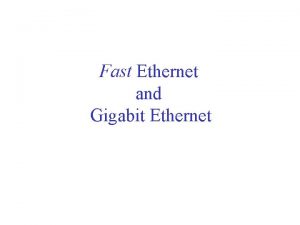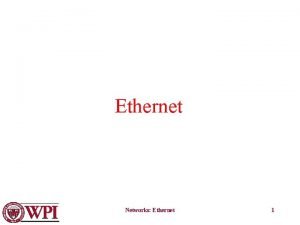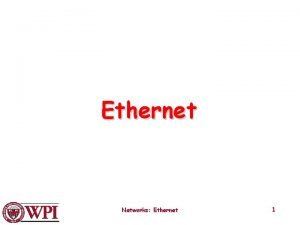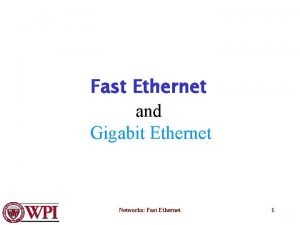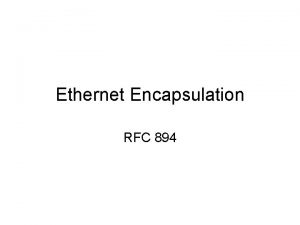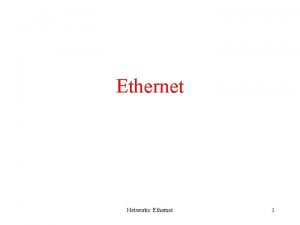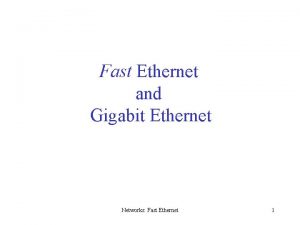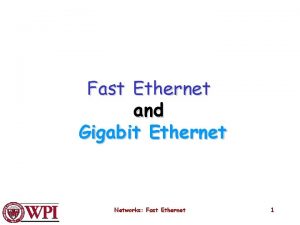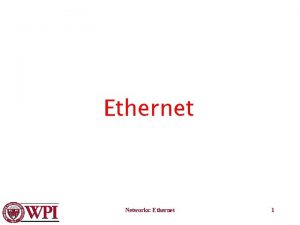Network Devices Ethernet Architecture What are internetworking devices





























- Slides: 29

Network Devices

Ethernet - Architecture

What are internetworking devices? Internetworking devices are products used to connect networks • As computer networks grow in size and complexity, so do the internetworking devices used to connect them. •

The purposes of having devices • First, they allow a greater number of nodes to be connected to the network. • Second, they extend the distance over which a network can extend. • Third, they localize traffic on the network. • Fourth, they can merge existing networks. • Fifth, they isolate network problems so that they can be diagnosed more easily.

What internetworking devices operate at the physical layer (layer 1) of the OSI model? • A repeater can provide a simple solution if either of these two problems exists. • When signals first leave a transmitting station, they are clean and easily recognizable • However, the longer the cable length, the weaker and more deteriorated the signals become as they pass along the networking media.

What is the disadvantage associated with using a repeater? • it can't filter network traffic. Data, sometimes referred to as bits, arriving at one port of a repeater gets sent out on all other ports • data gets passed along by a repeater to all other LAN segments of a network regardless of whether it needs to go there or no

What problem could occur as a result of too much traffic on a network? • if segments of a network are only connected by non-filtering devices such as repeaters, this can result in more than one user trying to send data on the network at the same time • If more than one node attempts to transmit at the same time, a collision will occur. • When a collision occurs, the data from each device impact and are damaged

Hub • Multi-port repeaters are often called hubs • Hubs are very common internetworking devices • Generally speaking, the term hub is used instead of repeater when referring to the device that serves as the center of a star topology network.

Hubs • Intelligent hubs have console ports, to allow monitoring of the hubs status and port activity. • Passive hubs just repeat any incoming signals to every port available, therefore does not act as a line repeater. • Passive hubs just split signals to multiple ports but do not regenerate the signals, which means that they do not extend a cable’s length. They only allow two or more hosts to connect to the same cable segment. • Active hubs regenerate signals. • Hubs utilise star topology.

Advantages • As an active hubs regenerate signals, it increases the distance that can be spanned by the LAN (up to 100 meters per segment). • Hubs can also be connected locally to a maximum of two other hubs, thereby increasing the number of devices that can be attached to the LAN. • Active hubs are usually used against attenuation, which is a decrease in the strength of the signal over distance.

Disadvantages • Bandwidth is shared by all hosts i. e. 10 Mbs shared by 25 ports/users. • Can create bottlenecks when used with switches. • Have no layer 3 switching capability. • Most Hubs are unable to utilise VLANS.

What internetworking device can be used to filter traffic on the network? • One way to solve the problems of too much traffic on a network and too many collisions is to use an internetworking device called a bridge. • A bridge eliminates unnecessary traffic and minimizes the chances of collisions occurring on a network by dividing it into segments

Bridges • A network bridge connects multiple network segments at the data link layer (layer 2) of the OSI model. • Bridges are similar to repeaters or network hubs, devices that connect network segments at the physical layer • However a bridge works by using bridging where traffic from one network is managed rather than simply rebroadcast to adjacent network segments • In Ethernet networks, the term "bridge" formally means a device that behaves according to the IEEE 802. 1 D standard this is most often referred to as a network switch in marketing literature.


At what layer of the OSI model do bridges operate? • Because bridges operate at the data link layer, layer 2, they are not required to examine upper-layer information. A bridge works at the data-link (physical network) level of a network, copying a data frame from one network to the next network along the communications path.

How are bridge dataforwarding decisions limited? • Although bridges use tables to determine whether or not to forward data to other segments of the network, the types of comparisons and decisions they make are relatively low level, simple ones

What types of network traffic problems is a bridge incapable of solving? • Bridges work best where traffic from one segment of a network to other segments is not too great. • However, when traffic between network segments becomes too heavy, the bridge can become a bottleneck and actually slow down communication

Transparent and Source Route Bridging • • Transparent Bridging This method uses a forwarding database to send frames across network segments. The forwarding database is initially empty and entries in the database are built as the bridge receives frames. If an address entry is not found in the forwarding database, the frame is rebroadcast to all ports of the bridge, forwarding the frame to all segments except the source address. Also known as adaptive bridges. • Route Source Bridging With source route bridging two frame types are used in order to find the route to the destination network segment. Single-Route (SR) frames comprise most of the network traffic and have set destinations, while All-Route(AR) frames are used to find routes. Bridges send AR frames by broadcasting on all network branches; each step of the followed route is registered by the bridge performing it.

ADVANTAGES • • • Self configuring Primitive bridges are often inexpensive Reduce size of collision domain Transparent to protocols above the MAC layer Allows the introduction of management performance information and access control • LANs interconnected are separate and physical constraints such as number of stations, repeaters and segment length don't apply

DISADVANTAGES • Does not limit the scope of broadcasts • Does not scale to extremely large networks • Buffering introduces store and forward delays on average traffic destined for bridge will be related to the number of stations on the rest of the LAN • Bridging of different MAC protocols introduces errors • Because bridges do more than repeaters by viewing MAC addresses, the extra processing makes them slower than repeaters • Bridges are more expensive than repeaters


How many addressing schemes are there in networking? • One of the addressing schemes is the MAC address • The second addressing scheme in networking makes use of what is called the IP address

How do IP addresses differ from MAC addresses? • Like MAC addresses, every IP address is unique. No two IP addresses are ever alike. • However, while MAC addresses are physical addresses that are actually hardcoded into the NIC card and occur at the data link layer • IP addresses are implemented in software and occur at the network layer of the OSI model.

Switches • A switch is a multi-port bridge. • It operates at OSI data link layer 2. • It stores MAC addresses in an internal lookup table. • Temporary switched paths are created between the frame’s source destination. • Some Switches have limited layer 3 IP routing capabilities. • Switches can be configured to use VLANS. • Switches support spanning tree protocol to create resilient networks.

What are routers? • Routers are another type of internetworking device. • These devices pass data packets between networks based on network protocol or layer 3 information. • Routers have the ability to make intelligent decisions as to the best path for delivery of data on the network.

Routers • Routers are OSI network layer 3 devices • Using interface modules can connect different layer 2 technologies e. g. Ethernet, FDDI, token ring etc… • Routers have the capability to interconnect network segments or entire networks (WANS/MANS). • These devices examine incoming packets to determine the destination address of the data. It then examines its internal routing table to choose the best path for the packet through the network, and switches them to the proper outgoing port.


What network problems can routers help resolve? • The problem of excessive broadcast traffic can be solved by using a router • Routers are able to do this, because they do not forward broadcast frames unless specifically told to do so

How do routers differ from bridges? • First, bridging occurs at the data link layer or layer 2, while routing occurs at the network layer or layer 3 of the OSI model. • Second, bridges use physical or MAC addresses to make data forwarding decisions. Routers use a different addressing scheme that occurs at layer three
 Antigentest åre
Antigentest åre Metro ethernet network architecture
Metro ethernet network architecture Internetworking concepts and architectural model
Internetworking concepts and architectural model Internetworking in network layer
Internetworking in network layer Switched ethernet vs shared ethernet
Switched ethernet vs shared ethernet Networking and internetworking devices
Networking and internetworking devices Internetworking devices
Internetworking devices Networking and internetworking devices
Networking and internetworking devices Ethernet pon
Ethernet pon Gigabit ethernet passive optical network
Gigabit ethernet passive optical network Ethernet network interface card
Ethernet network interface card Fast ethernet in computer networks
Fast ethernet in computer networks L connect 2
L connect 2 Advantages of internetworking
Advantages of internetworking Istilah internet merupakan singkatan dari ..
Istilah internet merupakan singkatan dari .. Principles of internetworking
Principles of internetworking Internetworking concepts
Internetworking concepts Internetworking business model
Internetworking business model Networking and internetworking
Networking and internetworking Connectionless internetworking
Connectionless internetworking Fileserver138
Fileserver138 Internetworking operating system
Internetworking operating system Architecture business life cycle
Architecture business life cycle Return architecture
Return architecture Fundamental and incidental interactions
Fundamental and incidental interactions Integral vs modular design
Integral vs modular design Buses in computer architecture
Buses in computer architecture Wcdma network architecture
Wcdma network architecture Osi security architecture
Osi security architecture Chordal ring
Chordal ring

